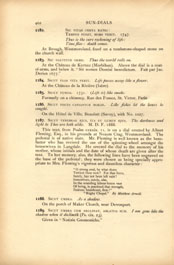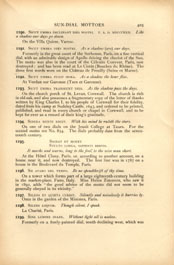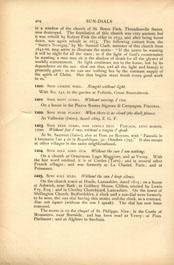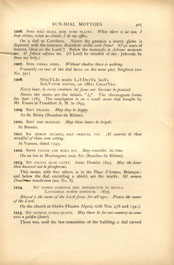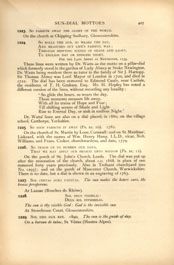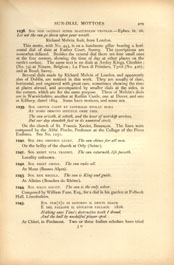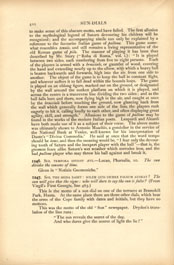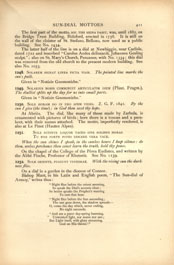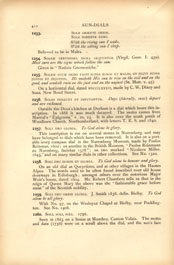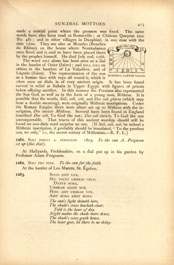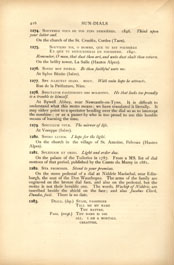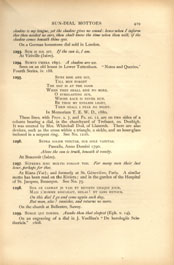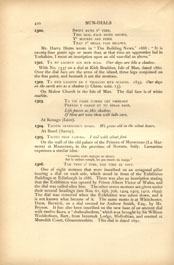Sun-Dial Mottoes (continued.)
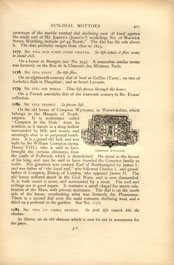
[Full Image]
COMPTON WYNYATES.
| prototype of the marble vertical dial declining east 16° fixed against the south end of Mr. Joanes's (Jones's?) workshop, No. 16 Warwick Street, Worthing, latitude 50° 49 North." The dial has Sic vita above it. The date probably ranges from 1800 to 1823. | |
| 1177. | SIC VITA DUM FUGIT STARE VIDETUR. So life while it flies seems to stand still. On a house at Bourges (see No. 593). A somewhat similar motto was formerly on the Rue de la Chaussée des Minimes, Paris. |
| 1178. | SIC VITA FUGIT. So life flies. On an eighteenth-century dial of lead at Guillac (Tarn); on two of Zarbula's dials in Dauphiné; and at Sestri Levante. |
| 1179. | SIC VITA PER HORAS. Thus life passes through the hours. On a French astrolabe dial of the sixteenth century in Mr. Evans' collection. |
| 1180. | SIC VITA TRANSIT. So passes life. On the old house of Compton Wynyates, in Warwickshire, which belongs to the Marquis of Northampton. It is sometimes called "Compton in the Hole" from its position, as it stands in a deep hollow surrounded by hills and woods, and seemingly shut in to perpetual loneliness. It is a grand old hall, and was built by Sir William Compton (temp. Henry VIII.), who is said to have brought the curious chimneys from the castle of Fulbrook, which is demolished. He stood in the favour of his king, and may be said to have founded the Compton family as noble. His grandson was created Earl of Northampton by James I., and was father of "the loyal earl," who followed Charles I., and grandfather of Compton, Bishop of London, who opposed James II. The old house suffered much in the Civil Wars, and is now dismantled. It is built round a court, and surrounded by a moat. The roof and ceilings are in good repair. It contains a small chapel for secret celebration of the Mass, with private staircases. The dial is on the south side of the house, overlooking what was formerly the Pleasaunce. There is a second dial over the main entrance, declining west, and a third on a pedestal in the garden. See No. 1172. |
| 1181. | SIC VITA UT UMBRA RECEDIT. So doth life vanish like the shadow. At Sierre, on an old château which is now let out in tenements for the poor. |
| 1182. |
At Brough, Westmoreland, fixed on a tombstone-shaped stone on the church wall. |
| 1183. | SIC VOLVITUR ORBIS. Thus the world rolls on. At the Château de Kernuz (Morbihan). Above the dial is a coat-of-arms, and below it, "Sit nomen Domini benedictum. Fait par Jac. Derien 1677." |
| 1184. | SICUT FLOS VITA PERIT. Life passes away like a flower. At the Château de la Rivière (Isère). |
| 1185. | SICUT FUMUS. 1731. (Life is) like smoke. Formerly on a chimney, Rue des Fosses, St. Victor, Paris. |
| 1186. | SICUT PISCES CAPIANTUR HORAE. Like fishes let the hours be caught. On the Hôtel de Ville, Beaufort (Savoy), with No. 1027. |
| 1187. | SICUT TENEBRAE EJUS, ITA ET LUMEN EJUS. The darkness and light to Thee are both alike. M. D. F. 1888. This text, from Psalm cxxxix. II, is on a dial erected by Albert Fleming, Esq., in his grounds at Neaum Crag, Westmoreland. The pedestal is of native slate. Mr. Fleming is well known as the benefactor who has revived the use of the spinning-wheel amongst the housewives in Langdale. He erected the dial to the memory of his mother, whose initials and the date of whose death are given after the text. To her memory, also, the following lines have been engraved on the base of the pedestal; they were chosen as being specially appropriate to Mrs. Fleming's vigorous and dauntless character:
|
| 1188. | SICUT UMBRA. As a shadow. On the porch of Maker Church, near Devonport. |
| 1189. | SICUT UMBRA CUM DECLINAT, ABLATUS SUM. I am gone like the shadow when it declineth (Ps. cix. 23). Given in "Notizie Gnomoniche." |
| 1190. | SICUT UMBRA DECLINANT DIES NOSTRI. F. A. D. MDCCCXXII. Like a shadow our days go down. On the Villa Quiete, Varese. |
| 1191. | SICUT UMBRA DIES NOSTRI. As a shadow (are) our days. Formerly in the great court of the Sorbonne. Paris, on a fine vertical dial, with an admirable design of Apollo driving the chariot of the Sun. The motto was also in the court of the Célestin Convent, Paris, now destroyed; and has been read at Le Ciotât (Bouches du Rhône). The three first words were on the Château de Preuilly (Seine et Marne). |
| 1192. | SICUT UMBRA FUGIT HORA. As a shadow the hour flies. At Verdun sur Garonne (Tarn et Garonne). |
| 1193. | SICUT UMBRA TRANSEUNT DIES. As the shadow pass the days. On the church porch of St. Levan, Cornwall. The church is rich in old oak, and also possesses a fragmentary copy of the letter of thanks written by King Charles I. to his people of Cornwall for their fidelity, dated from his camp at Sudeley Castle, 1643, and ordered to be printed, published, and read in every church or chapel in Cornwall, and to be kept for ever as a record of their king's gratitude. |
| 1194. | SIDERA MENTE REGIT. With his mind he ruleth the stars. On one of two dials on the Jesuit College at Tours. For the second motto see No. 854. The dials probably date from the seventeenth century. |
| 1195. |
SIGNAT ET MONET. It marks and warns, long to the fool; to the wise man short. At the Hôtel Cluny, Paris, or, according to another account, on a house near it, and now destroyed. The first line was in 1787 on a house in the Boulevard du Temple, Paris. |
| 1196. | SII AVARO DEL TEMPO. Be no spendthrift of thy time. On a tower which forms part of a large eighteenth-century building in the market-place, Fano, Italy. Miss Helen Zimmern, who saw it in 1892, adds "the good advice of the motto did not seem to be generally obeyed in its vicinity." |
| 1197. | SILENS ET QUIETA CURRIT. Silently and noiselessly it hurries by. Once in the garden of the Minimes, Paris. |
| 1198. | SILENS LOQUOR. Though silent, I speak. La Charité, Paris. |
| 1199. | SINE LUMINE INANE. Without light all is useless. Formerly on a finely-painted dial, south declining west, which was |
| in a window of the church of St. Benet Fink, Threadneedle Street, now destroyed. The foundation of this church was very ancient, but it was rebuilt by Robert Fink the elder in 1633, and after being burnt down, was again rebuilt in 1673. The following extract from the "Saint's Nosegay," by Mr. Samuel Clark, minister of this church from 1642-66, may serve to illustrate the motto: "If the sunne be wanting it will be night for all the stars; so if the light of God's countenance be wanting, a man may sit in the shadow of death for all the glyster of worldly contentment. As light continues not in the house, but by its dependance on the sun: shut out that, and all the light and beauty is presently gone: so we can see nothing but by the constant supply of the spirit of Christ. Hee that begins must finish every good work in us." | |
| 1200. | SINE LUMINE NIHIL. Nought without light. With No. 232, in the garden at Fellside, Great Snaresbrook. |
| 1201. | SINE MOTU CURRO. Without moving, I run. On a house in the Piazza Nostra Signora di Campagna, Piacenza. |
| 1202. | SINE NUBE PLACET. When there is no cloud (the dial) pleases. At Vallouise (Isère), dated 1869, Z. G. F. |
| 1203. | SINE PEDE CURRO, SINE LINGUA DICO. PASCALIS, ANNO DOMINI, 1790. Without feet I run, without a tongue I speak. At St. Sauveur (Isère), also at Pont en Royans, with "Pascalis le 8 brumaire l'an 4 de la Republique, 30: Octobre 1795." It also occurs at other villages in the same neighbourhood. |
| 1204. | SINE SOL NIHIL SUM. Without the sun I have nothing. On a church at Ornavasso, Lago Maggiore, and at Vevey. With the last word omitted, it is at Cordes (Tarn); and in several other French villages; and was formerly at La Charité, Paris; and at Puisseaux. |
| 1205. | SINE SOL SILEO. Without the sun I keep silence. On the church tower at Hoole, Lancashire, dated 1815; on a house at Ashwick, near Bath; at Goldney House, Clifton, erected by Lewis Fry, Esq.; and in Chorley Churchyard, Lancashire. On the tower of Shillington Church, Bedfordshire, a clock and a sun-dial were formerly to be seen, the sun-dial having this motto, and the clock, as a contrast. Sine sole loquor (without the sun I speak). The dial has now been removed. The motto is on the chapel of St. Philippe, Nice; in the Castle of Monastero, near Bormida; and has been read at Vevey; at Pino. Piedmont; and at Alghero in Sardinia. |
| 1206. | SINE SOLE SILEO, SINE NUBE PLACEO. When there is no sun, I keep silence, when no clouds, I do my office. On a dial at Cervières. Above the gnomon a starry globe is depicted, with the sentence. Benedicite stellae coeli Domie, (O ye stars of heaven, bless ye the Lord!) Below the numerals is Adonai memento me. O Jehova adjuva me. (O Lord, be mindful of me: Jehovah, be thou my help.) |
| 1207. | SINE UMBRA NIHIL. Without shadow there is nothing. Formerly on one of the dial faces on the west pier, Brighton (see No. 391). |
| 1208. |
SINGVLIS HORIS LAVDETVR IESVS Every hour, by every creature, let Jesus our Saviour be praised. Above the motto are the initials, F. C. R. PE.. The chronogram forms the date 1785. The inscription is on a small stone dial bought by Mr. Evans at Frankfort A. M. in 1893. |
| 1209. | SINT FELICES. May they be happy. At St. Rémy (Bouches du Rhône). |
| 1210. | SINT TIBI SERENAE. May thine hours be bright. At Bormio. |
| 1211. | SIS MEMOR OCCASUS, SOLE ORIENTE, TUI. At sunrise be thou mindful of thine own setting. At Vannes, dated 1743. |
| 1212. | SISTE VIATOR JAM HORA EST. Stay traveller, 'tis time. On an inn at Meyrargues, near Aix (Bouches du Rhône). |
| 1213. | SIT FAUSTA QUAE LATET. Anno Domini 1823. May the hour thou knowest not be prosperous. This motto, with five others, is in the Place d'Armes, Briançon; and below the dial, encircling a shield, are the words: Sit nomen Dominum benedictum (see No. 8). |
| 1214. |
SIT NOMEN DOMINUM JESU BENEDICTUM IN SECULA. Blessed is the name of the Lord Jesus for all ages. Praise the name of the Lord. On the church at Abriès (Hautes Alpes), with Nos. 478 and 1591). |
| 1215. | SIT PATRIAE AUREA QUAVIS. May there be for our country in some wise a golden (hour). There was, until the last restoration of the building, a dial carved |
in stone and bearing this motto, on the façade of the Maison du Roi, or Broodhuys, at Brussels. This fine old building is opposite the Hôtel de Ville, in the square where the executions of Counts Egmont and Horn took place. The Broodhuys has undergone many alterations. It was built about 1525. and in it the two noblemen passed the night before their execution, but it seems to have been rebuilt in 1668, by order of the Archdukes Albert and Isabella, and again altered in 1757. Until a recent restoration it bore on its façade the following inscription, which contains a chronogram of the date 1624:
A statue of the Archduchess was placed above. The dial probably dates from the rebuilding in 1757. |
|
| 1216. | SIT SINE LITE DIES. Let the day be without strife. On Darlington church. The dial is placed high on the south wall; the face is black, the lines and lettering gold. |
| 1217. | SIT ULTIMA FELIX. 1792. May thy last hour be happy. At Najac (Aveyron). |
| 1218. | ΣKIAΣ ΔIKHN ΠANTA. All passeth like a shadow. Hotel de Mars, Rue du Tournon, Paris. |
| 1219. | ΣKIAΣ 'ONAP 'ANΘPΩΠOI. Mankind is as the dream of a shadow. From Pindar, P. 8, 136, cf. Soph. Aj. 125:
ὁρῶ
γὰρ
ᾑμᾶς
οὐδὲν
ὄντας
ἄλλο
πλὴν
Formerly on the convent of the Minimes, in the Place Royal, Paris. |
| 1220. | SO FLIES LIFE. On an old house at Southall, Middlesex. |
| 1221. | SO FLIES LIFE AWAY. 1738. On the church tower at South Stoneham. Hampshire, "Jo. Sharpe, Ro: Houghton, Churchwardens;" also on "The Old Windmill" tavern at Turnham Green, Middlesex, with date, 1717. |
| 1222. | SO MARCHES THE GOD OF DAY. At Hartington Church, Derbyshire. The inscription is probably taken from Leadbetter's absurd translations of Latin dial mottoes. |
| 1223. | SO PASSETH AWAY THE GLORY OF THE WORLD. On the church at Chipping Sodbury, Gloucestershire. |
| 1224. |
SO ROLLS THE SUN, SO WEARS THE DAY, These lines were written by Dr. Watts as the motto on a pillar-dial which formerly stood in the garden of Lady Abney at Stoke Newington. Dr. Watts being resident there as tutor in the family of Sir J. Hartopp. Sir Thomas Abney was Lord Mayor of London in 1700, and died in 1722. The dial has been removed to Edmond Castle, near Carlisle, the residence of T. H, Graham, Esq. Mr. H. Hopley has noted a different version of the lines, without recording any locality: "So glide the hours, so wears the day, Dr. Watts' lines are also on a dial placed, in 1880, on the village school, Carthorpe, Yorkshire. |
| 1225. | SO SOON PASSETH IT AWAY (Ps. xc. 10). 1782. On the church of St. Martin by Looe, Cornwall; and on St. Matthias'. Liskeard, with the names of Wm. Henry Hony, LL.D., vicar, Neh. Williams, and Frans. Croker, churchwardens, and date, 1779. |
| 1226. |
SO TEACH US TO NUMBER OUR DAYS, On the porch of St. John's Church, Leeds. The dial was put up after the restoration of the church, about A.D. 1868, in place of one removed forty years previously. Also in Trefnant churchyard (see No. 1295); and on the porch of Mancetter Church, Warwickshire. There is no date, but a dial is shown in an engraving of 1763. |
| 1227. | SOL CERTAS AURA FAUSTAS. The sun makes the hours sure, the breeze prosperous. At Lausac (Bouches du Rhône). |
| 1228. |
SOL DEUS VISIBILIS: The sun is thy visible God; God is the invisible sun. At Stonehouse Court, Gloucestershire. |
| 1229. | SOL DIEI DUX EST. 1890. The sun is the guide of day. On a bureau de tabac, St. Véran (Hautes Alpes). |
| 1230. | SOL EST LUX ET GLORIA MUNDI. The sun is the light and glory of the world. One of the mottoes at Moccas Court (see No. 1469); also on a horizontal dial made by Newton, of Cambourne, and exhibited at Falmouth in 1898: "Lo ministro maggior della natura |
| 1231. | SOL EST REGULA. The sun is the rule. On a house at Briançon. See No. 1103. |
| 1232. | SOL ET LUNA FACIUNT QUAE PRECEPTA SUNT EIS: NOS AUTEM PEREGRINAMUR A DOMINO. The sun and moon do what hath been bidden them, but we wander away from the Lord. Near a great sun-dial on the parish church of St. Affrique (Aveyron). and described by Mr. Barker in his "Wanderings by Southern Waters." "The extraordinary astronomical dials," he writes, "cover most of the surface of the outer walls. They are exceedingly curious, and some of the calculations really astonishing, as e.g., a table showing the number of souls that have appeared before the tribunal of God." Baron de Rivière gives both this and another motto in French; possibly both versions may be on the dials (see No. 212). |
| 1233. | SOL GLORIA MUNDI. The sun is the glory of the world. On a house in Whitehorse Yard, Wellingborough. |
| 1234. | SOL LUCET OMNIBUS. The sun shineth for all men. On a house at Sècles (Carrèze); and at Pont de Beauvoisin (Isère). |
| 1235. | SOL ME VOS UMBRA REGIT. The sun guides me, the shadow you. On the church of St, Stephen by Saltash, which is the original parish church of Saltash, the names of Joseph Avery and Savell Doidge, 1783, are also engraved on the dial. The motto is on three of Zarbula's dials in the Hautes Alpes. Also on a farmhouse at Coldthorpe, Gloucestershire, the last word being omitted. |
| 1236. | SOL MINISTRAT UMBRAM. The sun provides the shadow. John Calcott fecit, 1824, George Ore, Samuel Worthen, Churchwardens. On the dial in the churchyard of Prees, Salop. |
| 1237. | SOL MOMENTA NICOLAUS MORES. 1666. The Sun makes the moments, Nicolas the manners. On the wall of the former presbytère of the church of St. Nicolas des Champs, Paris. |
| 1238. | SOL NON OCCIDAT SUPER IRACUNDIAM VESTRAM. – Ephes. iv. 26. Richard Melvin, fecit, from London. This motto, with No. 443, is on a handsome pillar bearing a horizontal dial of slate at Ember Court, Surrey. The inscriptions are somewhat defaced. Besides the central dial there are four small ones at the four corners, showing the time of day at other places on the earth's surface. The same text is on dials at Areley Kings, Cheshire; (No. 74) at Ninane, Belgium; La Fiera di Primiero, Tyrol (No. 426); and at Bozel, Savoy. Several dials made by Richard Melvin of London, and apparently also of Dublin, are noticed in this work. They are usually of slate, horizontal, and engraved with great care, sometimes showing the time at places abroad, and accompanied by smaller dials at the sides, in the corners, which are for the same purpose. Three of Melvin's dials are in Warwickshire, another at Ruthin Castle, one at Dover, and one at Killiney, dated 1864. Some have mottoes, and some not. |
| 1239. |
On the church of St. Francis Xavier, Besançon. The lines were composed by the Abbé Pioche, Professor at the College of the Pères Eudistes. See No. 1251. |
| 1240. | SOL PRO OMNIBUS LUCET. The sun shines for all men. On the belfry of the church at Orly (Seine). |
| 1241. | SOL REDIT VITA TRANSIT. The sun returneth, life passeth. Locality unknown. |
| 1242. | SOL REGIT OMNIA. The sun rules all. At Manc (Basses Alpes). |
| 1243. | SOL REX REGULA. The sun is King and guide. At Alleins (Bouches du Rhône). |
| 1244. | SOL SOLUS SOLVIT. The sun is the only solver. Composed by William Fane, Esci., for a dial in his garden at Fulbeck Hall, Lincolnshire. |
| 1245. |
At Chieri, in Piedmont. Two or three Italian scholars have tried |
| to make sense of this obscure motto, and have failed. The first allusion to the mythological legend of Saturn devouring his children will be recognized; and the accompanying simile can only be explained by a reference to the favourite Italian game of pallone. This game somewhat resembles tennis, and still remains a living representative of the old Roman game of pila. The manner of playing it has been thus described by Mr. Story ("Roba di Roma," vol. i.): "It is played between two sides, each numbering from five to eight persons. Each of the players is armed with a bracciale, or gauntlet of wood, covering the hand and extending nearly up to the elbow, with which a heavy ball is beaten backwards and forwards, high into the air, from one side to another. The object of the game is to keep the ball in constant flight, and whoever suffers it to fall dead within the bounds loses. The game is played on an oblong figure, marked out on the ground, or designated by the wall around the sunken platform on which it is played, and across the centre is a transverse line dividing the two sides; and as the ball falls here and there, now flying high in the air, and caught at once by the bracciale before touching the ground, now glancing back from the wall which generally forms one side of the lists, the players rush eagerly to hit it, calling loudly to each other, and often displaying great agility, skill, and strength." Allusions to the game of pallone may be found in the works of the modern Italian poets. Leopardi and Aleardi have both made use of it as a subject of their verse. The above motto was ultimately shown to Antonio Maschio, a gondolier in the service of the National Bank at Venice, well-known for his interpretation of Dante's "Divina Commedia." He said at once that the word tempo should be temo, and then the meaning would be, "I fear only the devouring tooth of Saturn and the inexpert player with the ball" – that is, the gnomon fears alike Saturn's wet weather which corrodes iron, and the bad pallone player who may throw his ball against and break it. | |
| 1246. | SOL TEMPORA DIVIDIT ÆVI. – Lucan, Pharsalia, 10. Given in "Notizie Gnomoniche." |
| 1247. | SOL TIBI SIGNA DABIT: SOLEM QUIS DICERE FALSUM AUDEAT? The sun will give thee the signs: who will dare to say the sun is false? (From Virgil's First Georgic, line 463.) This is the motto of a sun-dial on one of the terraces at Bramshill Park, Hants. At the same place there are three other dials, which bear the arms of the Cope family with dates and initials, but they have no mottoes. This was the motto of the old "Sun" newspaper. Dryden's translation of the line runs: "The sun reveals the secret of the day. |
The first part of the motto, SOL TIBI SIGNA DABIT, was, until 1852, on the Bridge Trust Building, Bideford, erected in 1755. It is still on the wall of the cloister of St. Stefano, Belluno, now used as a public building. See No. 1434. The latter half of the line is on a dial at Newbiggin, near Carlisle, dated 1722 and inscribed "Carolus Aedes delineavit, Johannes Gosling sculpt."; also on St. Mary's Church, Penzance, with No. 1334; this dial was removed from the old church to the present modern building. See also No. 1053. |
|
| 1248. | SOLARUM SIGNAT LINEA PICTA VIAM. The painted line marks the sun's path. Given in "Notizie Gnomoniche." |
| 1249. | SOLARIUS NOBIS COMMINUIT ARTICULATIM DIEM (Plaut. Fragm.), The diallist splits up the day for us into small parts. Given in "Notizie Gnomoniche." |
| 1250. | SOLE HORAM DO IN DEO SPEM VIDES. Z. G. F. 1841. By the sun I give (the time); in God thou seest thy hope. At Abriès. The dial, like many of those made by Zarbula, is ornamented with pictures of birds; here there is a toucan and a parakeet, with their names attached. The motto, imperfectly rendered, is also at Le Pinet (Hautes Alpes). |
| 1251. | SOLE NITENTE LOQUOR TACEO SINE SOLIBUS HORAS When the sun shines I speak, in the sunless hours I keep silence: do thou, unless perchance thou canst learn the truth, hold thy peace. On the chapel of the College of the Pères Eudistes, and written by the Abbé Pioche, Professor of Rhetoric. See No. 1239. |
| 1252. | SOLE ORIENTE, FUGIUNT TENEBRAE. With the rising sun the darkness flies. On a dial in a garden in the diocese of Connor. Bishop Mant, in his Latin and English poem, "The Sun-dial of Armoy," writes thus:
|
| 1253. |
SOLE ORIENTE ORIOR, Believed to be in Malta. |
| 1254. | SOLEM CERTISSIMA SIGNA SEQUUNTUR (Virgil, Geor. I. 439). Given in "Notizie Gnomoniche." |
| 1255. | SOLEM SUUM ORIRI FACIT SUPER BONOS ET MALOS, ET PLUIT SUPER JUSTOS ET INJUSTOS. He maketh His sun to rise on the evil and on the good, and sendeth rain on the just and on the unjust (St. Matt. v. 45). On a horizontal dial, dated MDCCCLXXXVI, made by C. W. Dixey and Sons, New Bond Street. |
| 1256. | SOLES PEREUNT ET IMPUTANTUR. Days (literally, suns) depart and are reckoned. Outside the Dean's kitchen at Durham is a dial which bears this inscription. In 1888 it was much decayed. The motto comes from Martial's "Epigrams," v. 20, 23. It is also over the south porch of Woodhorn Church, Northumberland, with letters T. R. S. and 1840. |
| 1257. | SOLI DEO GLORIA. To God alone be glory. This inscription is cut on several stones in Nuremberg, and may have belonged to dials which have been removed. It is also on a portable ivory compass dial in the Nuremberg Museum, made by Paulus Reinman, 1602; on another in the British Museum, "Paulus Reinmann zu Normberg, faciebat 1578"; on two marked "Nicolavs Miller, 1645," and on many similar dials in other collections. See No. 1320. |
| 1258. | SOLI DEO HONOR ET GLORIA. To God alone be honour and glory. On an old dial at Queyrières, and at other villages in the Hautes Alpes. The words used to be often found inscribed over old house doorways in Edinburgh; amongst others over the notorious Major Weir's house, dated 1604. Mr. Robert Chambers tells us that in the reign of Queen Mary the above was the "fashionable grace before meat" of the Scottish nobility. |
| 1259. | SOLI DEO OMNIS GLORIA. J. Smith 1838. delin. Bielby. To God alone be all glory. With No. 97, on the Wesleyan Chapel at Bielby, near Pocklington. See No. 1406. |
| 1260. | SOLI, SOLI, SOLI. 1756. Seen in 1863 on a house at Monthey, Canton Valais. The motto and date (1756) were on a scroll above the dial, and the sun's face |
made a central point where the gnomon was fixed. The same words have also been read at Bonneville; at Château Queyras (see No. 48); and in other villages in Dauphiné, in one case with the date 1700. They are also at Mouriez (Bouches du Rhône), on the house where Nostradamus once lived, and is said to have been placed there by the prophet himself. He died July 2nd, 1566. The word SOLI alone has been seen on a dial in the hamlet of Ozier (Isère); and SOLI, SOLI on others in the hamlets of La Valadière, and of Légerie (Isère). The representation of the sun as a human face with rays all round it, which is often seen on dials, is of very ancient origin. It has been found carved in relief at Babain in Upper Egypt, with figures of priests below offering sacrifice. In this manner the Persians also represented the Sun God, as well as in the form of a young man, Mithras. It is possible that the words, Soli, soli, soli, and Deo soli gloria (which may bear a double meaning), were originally Mithraic inscriptions. Under the Roman Empire there were altars set up to Mithras with the inscription, Deo invicto Mithrae. Several have been found in England inscribed Deo soli, To God the sun; Deo soli invicto, To God the sun unconquerable. That traces of this ancient worship should still be found on sun-dials need surprise no one. [If Soli, soli, soli, be indeed a Mithraic inscription, it probably should be translated, "To the peerless sun, we only," i.e., the secret society of Mithraists. – R. F. L.] |
|
| 1261. | SOLI POSUIT A. FERGUSON. 1803. To the sun. A. Ferguson set up [this dial). At Hallyards, Peeblesshire, on a dial put up in his garden by Professor Adam Ferguson. |
| 1262. | SOLI PRO FIDE. To the sun for the faith. At the hamlet of Les Murets, St. Égrève.
|
| 1263. |
|
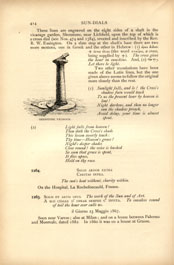
[Full Image]
SHENSTONE VICARAGE.
These lines are engraved on the eight sides of a shaft in the vicarage garden, Shenstone, near Lichfield, upon the top of which is a cross dial (see Nos. 474 and 1384), erected and inscribed by the Rev. R. W. Essington. On a slate step at the shaft's base there are two more mottoes, one in Greek and the other in Hebrew: (1) ὡραν διδωσι + ὀντος ἡλιου (the word σταῦρος, a cross, being supplied by +). The cross gives the hour in sunshine. And, (2) י ח י א ו ֹ ד . Let there be light. Two other translations have been made of the Latin lines, but the one given above seems to follow the original more closely than the rest.
|
|||||
| 1264. |
SOLIS ARDOR EXTRA The sun's heat without, charity within. On the Hospital, La Rochefoucauld, France. |
||||
| 1265. | SOLIS ET ARTIS OPUS. The work of the Sun and of Art. Seen near Varese; also at Milan; and on a house between Palermo and Monreale, dated 1882. In 1860 it was on a house at Grasse. |
| 1266. | SOLUS NON ERRAT. RECEDO NON DECEDO. OBLIQUE ET UBIQUE. He alone makes no mistake. I go back again. I do not go away. Aslant and everywhere. Given in "Notizie Gnomoniche." |
| 1267. |
SON FIGLIA DEL SOLE I am child of the sun, and yet am shade. Seen by the Countess Martinengo Cesaresco on the Col di Tenda in 1870. Dean Alford mentioned the same motto in his letters from the Riviera, and he paraphrased it thus: I the sun my father call, |
| 1268. | SON POCHE LE ORE MIE, LE TUE SON MOLTE. Few are my hours, how many thine! At San Remo; and also at Ventimiglia. |
| 1269. |
SON SENZA SUON E SENZA VOCE, ANCORA At Vegliasco, near Alassio. |
| 1270. | SONGEZ À DIEU ET AU PROCHAIN. 1860. Think upon God, and of thy neighbour. At Abriès (Hautes Alpes). |
| 1271. | SONGEZ À LA DERNIÈRE. 1733. Think upon the last (hour). On the church at Mens (Isère). |
| 1272. |
On the tower of the Grand Hotel, Pegli; placed there in 1874. and the motto added by the Marquis de Nicolay. |
| 1273. | SONO PRONTO A FAR OFFIZIO MIO; SE MANCHA IL SOLE M'ANCHO ANCH'IO. IN VANO CERCA LORA MENTRE NON È SOLE. [SONO PRONTO A FAR UFFIZIO MIO, SE MANCA IL SOLE MANCO ANCH'IO; IN VANO CERCAR L'ORA MENTRE NON È SOLE.] I am ready to do my duty; if the sun fails, I fail also. It is in vain to seek the hour when there is no sun. On No. 85, Via Vittorio Emanuele, Chiomonte (Prov. of Turin). |
| 1274. | SOUVENEZ VOUS DE VOS FINS DERNIÈRES. 1846. Think upon your latter end. On the church of the St. Crucifix, Cordes (Tarn). |
||||||||||||
| 1275. |
SOUVIENS TOI, O HOMME, QUE TU EST POUSSIÈRE Remember, O man, that dust thou art, and unto dust shalt thou return. On the belfry tower, La Salle (Hautes Alpes). |
||||||||||||
| 1276. | SOYEZ MOI FIDÈLE. Be thou faithful unto me. At Sylve Bénite (Isère). |
||||||||||||
| 1277. | SPE ILLECTAT INANI. MDCV. With vain hope he attracts. Rue de la Préfecture, Nice. |
||||||||||||
| 1278. | SPECTATOR FASTIDIOSUS SIBI MOLESTUS. He that looks too proudly is a trouble to himself. At Bywell Abbey, near Newcastle-on-Tyne. It is difficult to understand what this motto means; we have translated it literally. It may either point to a spectator bending over the dial so as to intercept the sunshine; or as a passer-by who is too proud to use this humble means of learning the time. |
||||||||||||
| 1279. | SPECULUM VITÆ. The mirror of life. At Voreppe (Isère). |
||||||||||||
| 1280. | SPERO LUCEM. I hope for the light. On the church in the village of St. Antoine, Pelvoux (Hautes Alpes). |
||||||||||||
| 1281. | SPLENDOR ET ORDO. Light and order due. On the palace of the Tuileries in 1787. From a MS. list of dial mottoes of that period, published by the Comte du Marsy in 1881. |
||||||||||||
| 1282. | STA PROMISSIS. Stand to your promises. On the stone pedestal of a dial at Niddrie Marischal, near Edinburgh, the seat of the Don Wauchopes. The arms of the family are engraved on the bronze dial face, and also on the pedestal, but the motto is not their heraldic one. The words, Wachop of Niddrie, are inscribed beside the shield on the face; and also Jacobus Clarke, Dundee, fecit. There is no date. |
||||||||||||
| 1283. |
|
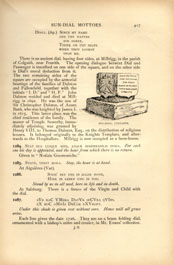
[Full Image]
MILLRIGG, CULGAITH.
There is an ancient dial, having four sides, at Millrigg, in the parish of Culgaith, near Penrith. The opening dialogue betwixt Dial and Passenger is inscribed on one side of the square, and on the other side is Dial's moral deduction from it. The two remaining sides of the square are occupied by the armorial bearings of the families of Dalston and Fallowfield, together with the initials "I. D." and "H. F." John Dalston resided and died at Millrigg in 1692. He was the son of Sir Christopher Dalston, of Acorn Bank, who was knighted by James I. in 1615. This latter place was the chief residence of the family. The manor of Temple Sowerby, immediately adjoining, was granted by Henry VIII. to Thomas Dalston, Esq., on the distribution of religious houses. It belonged originally to the Knights Templars, and afterwards to the Hospitallers. Millrigg is now occupied as a farm-house. |
|||||||||||||
| 1284. | STAT SUA CUIQUE DIES, ATQUE IRREMEABILIS HORA. For each one his day is appointed, and the hour from which there is no return. Given in "Notizie Gnomoniche." |
||||||||||||
| 1285. | STATE, VENIT HORA. Stay, the hour is at hand. At Aiguières (Var). |
||||||||||||
| 1286. |
STEH' BEY UNS IN ALLER NOTH, Stand by us in all need, here in life and in death. At Salzburg. There is a fresco of the Virgin and Child with the dial. |
||||||||||||
| 1287. |
SVB HAC VMBRA DATVR SECVRA QVIES. Under this shade is given rest without care. Hence will all grace arise. Each line gives the date 1726. They are on a brass folding dial, ornamented with a bishop's mitre and crozier, in Mr. Evans' collection. |
| 1288. |
SUB UMBRA QUIESCUNT. 1770. On the Hôtel des Invalides at Paris. |
| 1289. | SUCH IS LIFE. 1800. On the church at Buckminster, Leicestershire. |
| 1290. | SUFFICIT UNA, ULTIMAM TIME. One sufficeth, fear the last. In the principal square at Annecy a meridian dial was placed by Frère Arsène, a Capuchin, the maker of several dials set up at different places in Savoy. This one is described in a brochure, "Le Montre Solaire d'Annecy." There were, as is often the case, dials of different kinds on the same stone. On the south side were two equinoctial dials, with the mottoes given above, and the additional lines:
As a lion thirsting for blood pursues thy steps, so Azrael rapidly follows bearing thy death warrant. There are also the arms of the town of Annecy, and the initials L. D. M., L. J. F., which stand for "Laus Deo Mariæ, Laus Joseph Franciscus." On the east side is: "Une de plus, une de moins" – One more, one less; and on the west: "L'éternité dépend d'une heure" – Eternity hangs upon an hour. |
| 1291. |
SUM GENITOR VERI, DOMITOR LEVORIS, APERTI I am the father of truth, the conqueror of malice, the pointer of the open sky, the son and comrade of the stars. I follow myself and flee along my own tracks, daily am I born, daily I die. At the Hameau de Platre-Rousel, near Monbonnet (Isère). |
| 1292. |
SUM MUTUM AT MUTI TAMEN EXPLICO LUMINA PHŒBI Voiceless am I, yet do I interpret the light of voiceless Phœbus. The |
shadow is my tongue, yet the shadow gives no sound: hence when I inform thee thou needest no ears, thou shalt know the time when thou wilt, if the shadow comes beneath thine eyes. On a German honestone dial sold in London. |
|
| 1293. | SUM SI SOL SIT. If the sun is, I am. At Viriville (Isère). |
| 1294. | SUMUS UMBRA 1691. A shadow are we. Seen on an old house in Lower Tottenham. "Notes and Queries," Fourth Series, iv. 188. |
| 1295. |
SUNS RISE AND SET, These lines, with Prov. x. 7, and Ps. xc. 12, are on two sides of a column bearing a dial, in the churchyard of Trefnant, co. Denbigh. It was erected by Mrs. Whitehall Dod, of Llanerch. There are also devices, such as the cross within a triangle, a sickle, and an hour-glass inclosed in a serpent ring. See No. 1226. |
| 1296. | SUPRA SOLEM VERITAS, SUB SOLE VANITAS. At Beauvoir (Isère). |
| 1297. | SUPREMA HÆC MULTIS FORSAN TIBI. For many men their last hour, perhaps for thee. At Rians (Var); and formerly at St. Géneviève, Paris. A similar motto has been read on the Riviera; and in the garden of the Hospital of St. Jacques, Besançon. See No. 75. |
| 1298. |
SUR CE CADRAN JE VAIS ET REVIENS CHAQUE JOUR, On the church at Bellentre, Savoy. |
| 1299. | SURGE QUI DORMIS. Awake thou that sleepest (Eph. v. 14). On an engraving of a dial in J. Voellius's "De horologiis Sciothericis." 1608. |
| 1300. |
SWIFT RUNS YE TIME, Mr. Harry Hems wrote in "The Building News," 1888: "It is twenty-four years ago or more that, at that time an apprentice lad in Yorkshire, I recut an inscription upon an old sun-dial as above." |
| 1301. | TA NY LAGHYN AIN MYR SCAA. Our days are like a shadow. With No. 1337 on a dial at Kirk Braddan, Isle of Man, dated 1860. Over the dial face are the arms of the island, three legs conjoined on the fess point, and beneath it are the mottoes. |
| 1302. | TA NYN LAGHYN ER Y THALLOO MYR SCADOO. 1835. Our days on the earth are as a shadow (I Chron. xxix. 15). On Malew Church in the Isle of Man. The dial face is of white marble. |
| 1303. |
TA VIE PASSE COMME CET OMBRAGE At Renage (Isère). |
| 1304. | TACITIS SENESCIMUS HORIS. We grow old in the silent hours. At Bozel (Savoy). |
| 1305. | TACITO PEDE LABORO. I toil with silent foot. On the wall of the old palace of the Princes of Masserano (La Marmora) at Masserano, in the province of Novara, Italy. Lamartine expresses a similar idea: "L'ombre seule marque en silence |
| 1306. | TAK TENT O' TIME, ERE TIME BE TINT. One of eight mottoes that were inscribed on an octagonal pillar bearing a dial on each side, which stood in front of the Exhibition Buildings at Edinburgh in 1886. There was also an inscription stating that the Exhibition was opened by Prince Albert Victor of Wales, and the dial was called after him. The other seven mottoes are given under their several headings (see Nos. 61, 656, 706, 1404, 1405, 1412, 1649). The dial was removed when the Exhibition was taken down, and it is not known what became of it. The same motto is at Whitchester, Duns, Berwick, on a dial erected for Andrew Smith, Esq., by Mr. Bryson. It has also been inscribed on the new base of an ancient dial with twelve faces, a "dodecahedron," which was brought by Sir William Wedderburn, Bart., from Inveresk Lodge, Midlothian, and erected at Meredith Court, Gloucestershire. This dial is dated 1691. |
